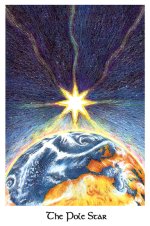Mi-Shell
From Chesca Potter's notes:
The Pole Star
Minor arcana; Aces
Position on wheel: Imbolc.
element: earth/fire
Chakra: crown.
Colour: Violet.
Polarity: white.
Time of day: first light
If The Ancestor is associated with the beginnings of human consciousness, and the formulation of a mythology based on the interaction between people and the land; then the Star is concerned with creation myths of the earth itself. Where do we come from? Is there a spiritual consciousness behind our existence? Is there a deeper purpose underlying our lives? Ancient beliefs thought that the souls of the dead returned to the stars, and new born souls came into physical incarnation from the stars. Nowadays great importance is placed on recording our exact time of birth so that our astrological chart can be generated, giving us a life pattern based on the interaction between earth, planets and constellations.
We consist of atoms and particles like stars. The most ancient symbol of life and death in European culture is the cup and ring mark, and this is the shape made by stars forming themselves in the cosmos. This shape itself clarifies why The Star card is linked to the Aces-from nothing, something is formed, i.e. 0 becomes one. The Star and The Ancestor form a creation myth; because this has been forgotten it is important to restate it.
‘From the essence of stars in the universe, the earth was created, and was blessed. The first tree on earth was the silver birch; the World Tree. From the tree emerged its guardian, the first reindeer, The Primal Creatress, who waits until the first light, the dawn of human consciousness, aware of the guidance and blessing of her origins The Star. With an archaic singing, She drums the manifest world into being. First the four elements, the Breath of life, the Spark of life, the Waters of life, and the first land-the Foundation. Then She calls the primal forest, the birds and animals, the first people. She then marks out the first pathway with her own totem, the reindeer. And she will walk forever with all generations, so that they may remember their origins in the stars, and learn wisdom from those who have preceded them.’
In the picture of The Star card, healing, radiance and a renewal of blessing pours down upon the pole (crown) of the earth.
By visualising this card and the purity of the four elements, you can work towards healing the terrible damage we have inflicted upon the ozone layer, water system and the earth itself.
Positive, focused and energised visualisation is a very powerful means of effecting change.
Drawing The Star card signifies a renewal of spiritual energy, cleansing and healing, a revitalised sense of direction, guidance from your ‘lucky star’, an intuitive knowledge of your destiny.
The Pole Star
Minor arcana; Aces
Position on wheel: Imbolc.
element: earth/fire
Chakra: crown.
Colour: Violet.
Polarity: white.
Time of day: first light
If The Ancestor is associated with the beginnings of human consciousness, and the formulation of a mythology based on the interaction between people and the land; then the Star is concerned with creation myths of the earth itself. Where do we come from? Is there a spiritual consciousness behind our existence? Is there a deeper purpose underlying our lives? Ancient beliefs thought that the souls of the dead returned to the stars, and new born souls came into physical incarnation from the stars. Nowadays great importance is placed on recording our exact time of birth so that our astrological chart can be generated, giving us a life pattern based on the interaction between earth, planets and constellations.
We consist of atoms and particles like stars. The most ancient symbol of life and death in European culture is the cup and ring mark, and this is the shape made by stars forming themselves in the cosmos. This shape itself clarifies why The Star card is linked to the Aces-from nothing, something is formed, i.e. 0 becomes one. The Star and The Ancestor form a creation myth; because this has been forgotten it is important to restate it.
‘From the essence of stars in the universe, the earth was created, and was blessed. The first tree on earth was the silver birch; the World Tree. From the tree emerged its guardian, the first reindeer, The Primal Creatress, who waits until the first light, the dawn of human consciousness, aware of the guidance and blessing of her origins The Star. With an archaic singing, She drums the manifest world into being. First the four elements, the Breath of life, the Spark of life, the Waters of life, and the first land-the Foundation. Then She calls the primal forest, the birds and animals, the first people. She then marks out the first pathway with her own totem, the reindeer. And she will walk forever with all generations, so that they may remember their origins in the stars, and learn wisdom from those who have preceded them.’
In the picture of The Star card, healing, radiance and a renewal of blessing pours down upon the pole (crown) of the earth.
By visualising this card and the purity of the four elements, you can work towards healing the terrible damage we have inflicted upon the ozone layer, water system and the earth itself.
Positive, focused and energised visualisation is a very powerful means of effecting change.
Drawing The Star card signifies a renewal of spiritual energy, cleansing and healing, a revitalised sense of direction, guidance from your ‘lucky star’, an intuitive knowledge of your destiny.


